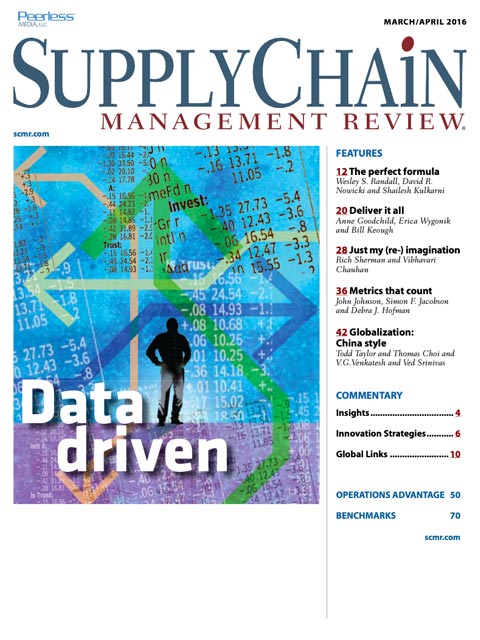Sorry, but your login has failed. Please recheck your login information and resubmit. If your subscription has expired, renew here.
March-April 2016
When I visit my millennial-aged daughter in Chicago, I’m amazed at the number of packages dropped off by UPS, FedEx and the USPS at her three-unit building on a daily basis. It’s as if she and her neighbors are single-handedly keeping Amazon in business. All those drop-offs got me to wondering: Does any of this make sense if you think about a carbon footprint? Rather than deliver millions of packages to one address at a time every day, wouldn’t it be more sustainable if we all just drove to the mall to do our shopping? After all, doesn’t research indicate that a signi cant percentage of consumers, especially millennial consumers like my… Browse this issue archive.Need Help? Contact customer service 847-559-7581 More options
Over the years, measuring manufacturing performance has been an ongoing challenge for companies. Plants have operated in isolation, disconnected from the supply chain, or have employed metrics that are diametrically opposed to the end goals of the business, such as choosing to focus on efficiency and uptime when flexibility is required.
Isolation and disconnection is no longer acceptable in today’s global economy. The growth in product portfolios and the expansion of supply networks to reach more markets puts a strong focus on the need to have reliable and integrated manufacturing processes and measure them as part of the end-to-end supply chain. The question is: What are the metrics and alignment best practices that are driving manufacturing excellence today?
In 2015, Gartner conducted a survey in conjunction with Supply Chain Management Review (SCMR) to address that question and to gain a better understanding of how manufacturing metrics are characterized, developed, and used to link manufacturing and supply chain performance.
 |
This complete article is available to subscribers
only. Click on Log In Now at the top of this article for full access. Or, Start your PLUS+ subscription for instant access. |
SC
MR
Sorry, but your login has failed. Please recheck your login information and resubmit. If your subscription has expired, renew here.
March-April 2016
When I visit my millennial-aged daughter in Chicago, I’m amazed at the number of packages dropped off by UPS, FedEx and the USPS at her three-unit building on a daily basis. It’s as if she and her neighbors are… Browse this issue archive. Access your online digital edition. Download a PDF file of the March-April 2016 issue.
 |
Download Article PDF |
Over the years, measuring manufacturing performance has been an ongoing challenge for companies. Plants have operated in isolation, disconnected from the supply chain, or have employed metrics that are diametrically opposed to the end goals of the business, such as choosing to focus on efficiency and uptime when flexibility is required.
Isolation and disconnection is no longer acceptable in today's global economy. The growth in product portfolios and the expansion of supply networks to reach more markets puts a strong focus on the need to have reliable and integrated manufacturing processes and measure them as part of the end-to-end supply chain. The question is: What are the metrics and alignment best practices that are driving manufacturing excellence today?
In 2015, Gartner conducted a survey in conjunction with Supply Chain Management Review (SCMR) to address that question and to gain a better understanding of how manufacturing metrics are characterized, developed, and used to link manufacturing and supply chain performance.
 |
SUBSCRIBERS: Click here to download PDF of the full article. |
SC
MR

Latest Supply Chain News
Latest Podcast

 Explore
Explore
Topics
Latest Supply Chain News
- Strengthening customer fulfillment: Building a strategic stakeholder network
- The hard job of teaching soft skills
- Trump picks former Wisconsin congressman Sean Duffy for DOT secretary
- Made in Mexico, manufactured by China
- Retail sales see gains in October, reports Commerce and NRF
- Balancing green and speed: Home delivery insights from the pandemic era
- More latest news
Latest Resources

Subscribe

Supply Chain Management Review delivers the best industry content.

Editors’ Picks





